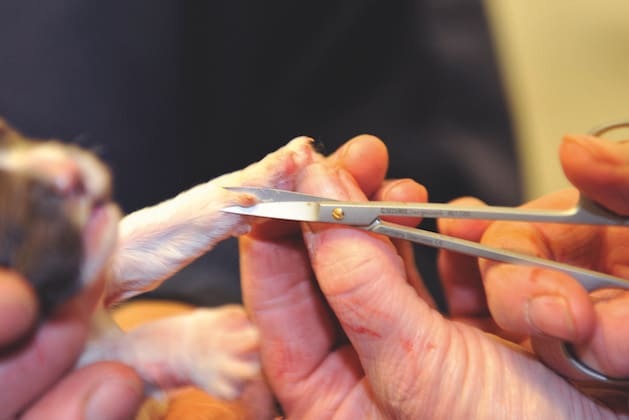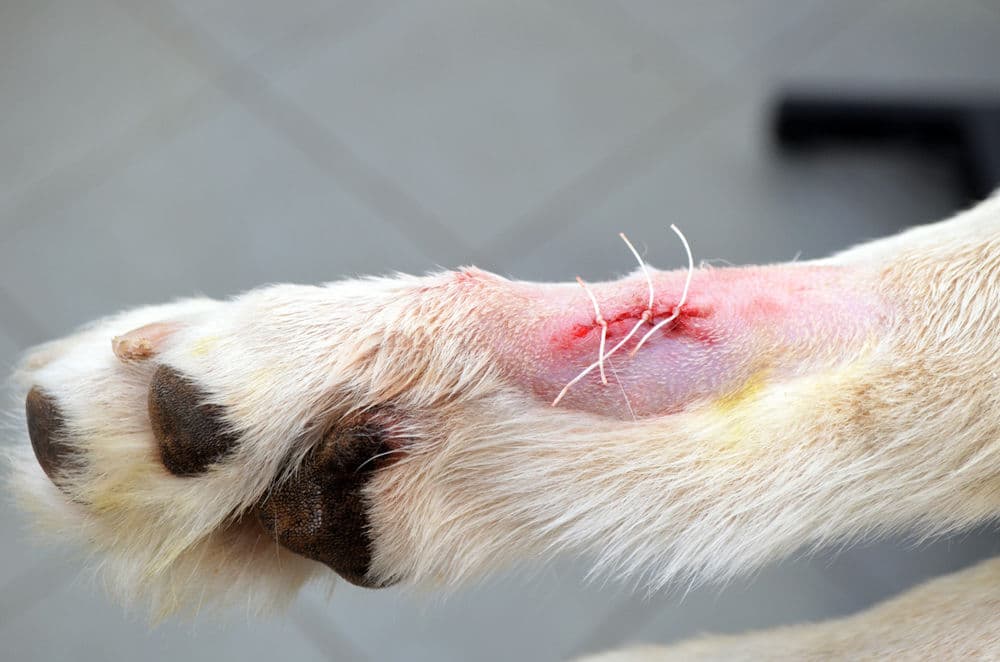Although some people believe that dewclaws are dead appendages, they serve a purpose.
For instance, dewclaws often act as stabilizers when a dog is running by taking off pressure from a dog’s toes while negotiating sharp corners.
Some dogs also use claws to hold objects, climb trees, or climb out of the water after breaking through ice.
The only issue with dewclaws is the possibility of them getting caught on something, especially for dogs who like to spend their time outdoors or on rough terrains where trees, roots, and other hazards are common.
Consequently, some dog parents will have them removed to reduce possible tears, injuries, and infections (especially for working dogs that frequent forests and craggy areas).
And in certain dog breeds, the removal of the dewclaw is thought to boost appearance for the show ring.
If you choose to have a dog’s dew claws removed, there are certain things you need to keep in mind—one of the most important being timing.
So, When is the Right Time to Remove the Dew Claws?
In most cases, dewclaws are removed at 3-5 days of age.
The removal process at that stage is quite simple as the puppy’s bones are still soft and the muscle tissues have not developed well.
Besides, the blood vessels and nerve endings of 3-5 day old puppies are not yet fully developed, so they feel less pain. In fact, some puppies don’t even squeak as the vet snipes the dewclaw off.
If the dewclaws aren’t removed a few days after birth (or in 3-5 days), the next opportunity is when the dog is being spayed or neutered.
Given that the anesthetic is often one of the most costly parts of the procedure, you will save a lot of money if you have the dewclaw removed while your pup is under the general anesthetic for other procedures like spaying or neutering.
Doing both procedures at the same time also lessens stress on your dog.
How Late Can You Remove Dew Claws?
Many puppies aren’t taken to the vet when they are under 5 days of age, which simply implies one thing: most will be older when the need to remove their dew claws arises.
Additionally, if a puppy has injured his dew claws before he is ready for spaying or neutering, it is certainly worth having the claws removed to prevent more cases of injuries.
But how late can this be done?
Well, dewclaws can be removed in older dogs—and at any age.
However, it is not only more costly but also more painful and traumatic to the dog because the tissues are already too hardened. That’s why most vets only recommend the procedure to be done in adult dogs for medical, rather than aesthetic reasons.
In fact, if the dewclaws are connected to the bone of the dog’s paw and not hanging loosely, most vets will discourage their removal unless it is a medical emergency.
If you are planning to have the procedure done on your older dog, therefore, we recommend discussing with your vet first so that you are up to date with the pros and cons of dewclaw removal at this particular stage of your pup’s life.
A vet can also help you estimate the overall cost of the procedure given that it must now be done under anesthesia.
What to Expect During Dew Claw Removal Procedure

The first step entails putting local nerve blocks around the dewclaw to numb the area.
A scalpel, laser, or a pair of scissors is then used to cut the claw off.
The wound is then closed with sutures or glued with surgical glue.
The area is then bandaged for the day/night or for a few days.
The vet then prescribes appropriate pain-relieving medications to help you keep the dog calm at home.
Your pup will also be given a cone to wear afterward to discourage him from chewing or licking the sutures underneath.
The wound should heal in 1-2 weeks and that’s the time when the sutures and the cone are removed.
Related Posts:
How Long Should A Dog Wear Cone After Surgery?
How to Stop a Dog from Licking his Wound without using a Collar
Dew Claw Removal Complications
The overall risk of a dewclaw removal surgery is very low.
The main complications or risks are bleeding (hemorrhage), post-operative infections, and re-growth of the nail.
Given that dewclaws often play a critical role in preventing torque on the limb, their removal may also predispose other digits to injury.
Finally, the use of general anesthesia often comes with standard risks like dizziness, bruising, nausea, visual impairment, kidney failure, cardiac arrest, etc.
Conclusion
Like other elective procedures in dogs, the subject of removing dog claws is marred with a lot of controversies.
When all is said and done, it is a decision that can only be taken by a dog parent who is responsible for the welfare of a dog under his or her care.
As we’ve seen, while the procedure is often done when a dog is under 5 days of age, it is still possible to do it at any age.
However, if the dewclaws aren’t causing your fur baby any distress nor posing any injury risk, it is advisable to leave them intact as opposed to subjecting your dog to expensive surgery that can also turn out to be traumatic.
But choosing not to remove the dewclaw also comes with certain responsibilities: the need to pay closer attention to keeping the dewclaw nails trimmed short.
If anything, most of the time dew claw gets injured, it catches on something.
Related Posts:
How to Tell If Dew Claw Is Dislocated
How to Find the Quick on Black Dog Nails
10 Best Dog Nail Clippers with Light
Should You Trim the Hair between a Dog’s Pads?
As an Amazon Associate, we may receive a small commission from qualifying purchases but at no extra cost to you. Learn more. Amazon and the Amazon logo are trademarks of Amazon.com, Inc, or its affiliates.

